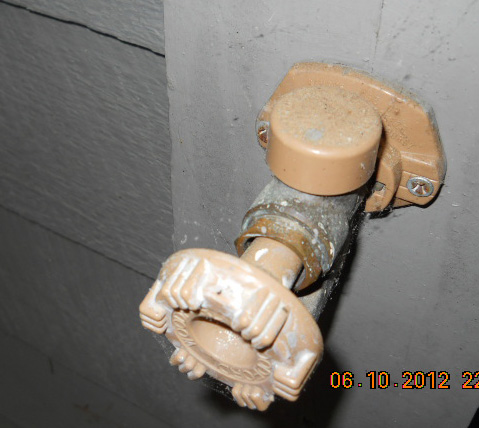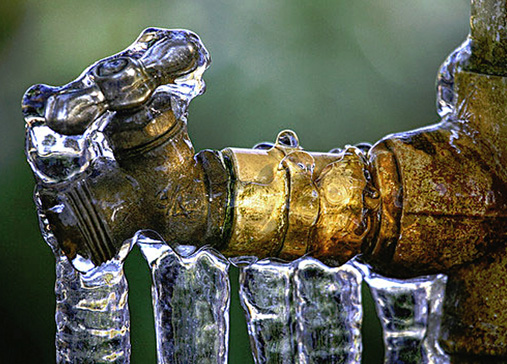There are a few things you should do every year, as temperatures begin to drop. As fall arrives, watch out for colder temperatures at night. It was recently about 37*F around here, and that was near the end of September. Freezing temperatures can damage your house if you have not prepared.
Your House & Freezing Weather
One of the simplest and most important things is something not many people think about:
Remove your exterior hoses from your hose bibbs.
(A hose “bibb” is an exterior water faucet with a threaded end that will allow you to screw hose connections to the faucet, for the use of pressurized water around your residence.)
The reason? Because even if your hose bibb has a vacuum break device on it, a hose connected to the hose bibb can still hold water in the faucet and when the temperature drops below freezing (32*F), the water will begin to freeze. Then the freezing water will expand by 1/10th its liquid size, quite possibly smashing the inside of the hose bibb outward, fracturing the metal, ruining the faucet and this will result in possible leaking inside the wall and for sure a huge torrent of water will come rushing out of the destroyed hose bibb as soon as the ice thaws. This can result in thousands of gallons of wasted water and even perhaps severe water damage to your house’s walls and other components to the side and under the level of the hose bibb. Water damage can be in the form of water saturated-insulation, which can react like cotton candy to water, compacting and crushing with the weight of the water. Mold and other toxic growth can occur inside walls and on other surfaces, making an unhealthy environment for your family, and structural wood elements can rot, when exposed to water for periods of time.
Okay. Now that you have your exterior hoses removed from your hose bibbs, we need to do something else:
Make sure that all of your exterior hose bibbs have vacuum breakers.

That’s what makes a “frostproof” hose bibb capable of resisting freezing temperatures. They drain excess water out of the exposed portions of the hose bibb. They look like the tan colored cylindrical feature on a hose bibb for integral factory-made frostproof hose bibbs, although they can also be field-added, as a brass cylinder screwed on to the threaded exposed exterior end of your hose bibb. These type of after-market vacuum breakers also have male threaded connections exposed to allow the female hose fitting to connect to them.
Turn off cold wall hose bibb supply line shutoff valves.
Next, make sure that if your hose bibbs happen to have been installed in a cold wall (a wall that does not have a heated space on its other side, as may be the case for a garage wall), that you check for a water shutoff line valve. This shutoff line valve is typically installed by prudent plumbers who know that a water pipe inside a cold wall will probably freeze and burst and leak. To avoid this, they often install a valve (inside a wall that has heat on at least one side) to allow you to turn off the water supply to that length of pipe that feeds your hose bibb on the cold wall. Then you can open the hose bibb faucet and allow the water that is in this line to drain. Then you can close the hose bibb faucet, and it is ready for cold weather. If you discover that your hose bibbs that are mounted on a cold wall do Not have a shut off line valve, immediately contact a licensed plumber to install one, before you have a frozen water line problem!
Now, finally your exterior hoses and hose bibbs are taken care of; who would have guessed that so much about getting ready for cold weather had to do with those little water valves on your walls around your house?
Other items for cold weather preparation:
We will have future posts about additional precautions for cold weather, with subjects like the following:
– Weatherstripping around doors and windows.
– Adequacy of insulation in walls, floors & ceilings, and around doors & windows.
– Windows: at least double pane.
– Exterior wall siding: plugging gaps.
– Flashing: at walls and roofs and doors & windows.
– Sealant application at a variety of locations.
– Exhaust vents ductwork and exhaust vent dampers.
– Heat Pumps, gas-fired heating equipment, resistance heat.
– Trees, limbs, branches and your house.
– Earth around your house.
– and more!
To find a residential architect to design your new house or your renovation and additions, contact: Rand Soellner, AIA of the HOME ARCHITECTS ® at: 1-828-269-9046 or e-mail: Rand@HomeArchitects.com .
tags: freezing weather, hose bibbs, cashiers, hendersonville, new york, virginia, roanoke, las vegas, nevada, aspen, telluride, orlando, atlanta, newnan


2 Comments
Matt Kolousek
8:01 am - October 2, 2012Very timely and well written post! Frozen hose bibbs often lead to a leak that can be difficult and expensive to fix.
Matt Kolousek
8:03 am - October 2, 2012Timely and well written post! I have seen many freeze damaged hose bibbs over the years that led to difficult and sometimes expensive repairs for homeowners.